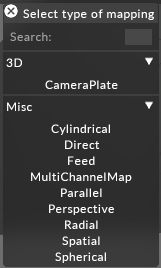
Direct
Direct mapping is the easiest form of mapping. Simply select a piece of content and apply it directly onto some or all of your screens. If the content aspect is different from the screen aspect ratio, you can choose to crop, fit, stretch or apply the content pixel-perfect onto the screens.
Feed mapping
Feed mapping lets you specify an arbitrary number of rectangles within your content frame and map them to arbitrary rectangles on your screens. With Feed mapping, all your screens can easily be turned into one canvas, with pixel-perfect content applied. Individually move, scale, crop, chop or flip your sample rectangles to compensate for differences in pixel-density or to create interesting mapping effects.
Parallel
Parallel mapping allows you to position your content in a virtual emitter rectangle anywhere within the stage and to choose which screens and fixtures this affects. The Disguise software then virtually projects the content out onto those fixtures. The content keeps the same size as it gets further away from the emitter.
Perspective
Perspective mapping is similar to Parallel mapping, except that the content originates from an emitter point and gets larger as you get further away from the emitter, similar to a real projector. You can use perspective mapping to map 3D content onto a surface that looks perfect from the specified point of view.
Cylindrical mapping
Cylindrical mapping is similar to Parallel mapping, except that the Cylindrical mapping wraps content around a cylinder and fires it outwards (or inwards) at the screens you assign to it. It does not matter if the screen is moving or expanding, the Cylindrical mapping feature re-maps the content in real-time.
Radial
Radial mapping is similar to the Cylindrical mapping, except that the emitter surface runs from the central axis to the cylinder rim, rather than being wrapped around the outside of the cylinder. The pixels inside the cylinder will therefore be mapped according to their height within the cylinder and their distance from the central axis.
Spherical
Spherical Mapping works similarly to the Cylindrical mapping, except the top and bottom are 'pinched' to create a sphere.
CameraPlate
A CameraPlate mapping is a 3D Camera based mapping that is fixed to the plate of the camera. Using a CameraPlate mapping is necessary when doing color adjusts on the set extension.
Spatial
A Spatial mapping is a 3D Camera based mapping that maps into 3D space; it has a “space” or location so it can be moved around 3D environments.
MultiChannelMap
The default mapping for the RenderStream layer, the MultiChannelMap allows you to assign multiple mappings to multiple unique RenderStream channels so you can manage all within the same mapping.